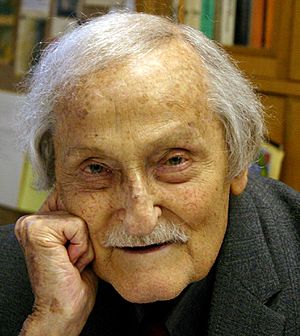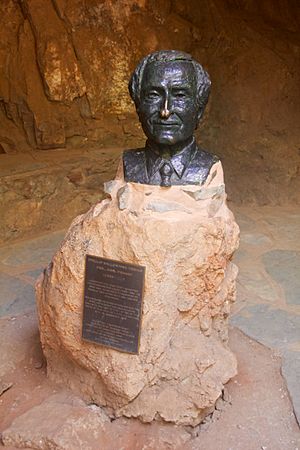Phillip Tobias facts for kids
Quick facts for kids
Phillip Tobias
|
|
|---|---|

Phillip Vallentine Tobias
|
|
| Born |
Phillip Vallentine Tobias
14 October 1925 |
| Died | 7 June 2012 (aged 86) |
| Nationality | South African |
| Alma mater | University of Witwatersrand |
| Known for | Paleoanthropological and evolutionary work |
| Awards | Fellow of the Royal Society |
| Scientific career | |
| Fields | Anthropology |
| Thesis | Chromosomes, Sex Cells, and Evolution in the Gerbil (1953) |
| Influenced | Patricia Vinnicombe |
Phillip Vallentine Tobias (14 October 1925 – 7 June 2012) was a famous South African scientist. He was a palaeoanthropologist, which means he studied ancient humans and their ancestors using fossils. He was a professor at the University of the Witwatersrand in Johannesburg. Phillip Tobias was especially known for his important discoveries at fossil sites in South Africa. He also worked hard to end apartheid, which was a system of unfair racial separation in South Africa. He gave many speeches against it.
Contents
Phillip Tobias's Early Life and Education
Phillip Tobias was born in Durban, South Africa, on 14 October 1925. He was the only son of Joseph Newman Tobias and Fanny Rosendorff. He went to school in Bloemfontein and Durban.
In 1945, Phillip Tobias began his career at the University of Witwatersrand. He worked as a demonstrator in histology (the study of tissues) and an instructor in physiology (the study of how living things work). He earned his Bachelor of Science degree in 1947. In 1948, he became the President of the National Union of South African Students (NUSAS). This group worked for student rights and against apartheid. He finished his medical degree in 1950 and became an anatomy lecturer in 1951. In 1953, he earned his PhD for his research on chromosomes and evolution.
Studying Around the World
In 1955, Tobias went to the University of Cambridge in England for more research. He studied physical anthropology there. The next year, he traveled to the University of Michigan and the University of Chicago in the United States. There, he studied anthropology, human genetics, and how teeth grow.
In 1959, he became a Professor and Head of the Department of Anatomy and Human Biology at his home university. He took over from his teacher, Professor Raymond Dart. In 1967, he received another special degree, a Doctor of Science, for his work on how humans evolved. He was also the Dean of Medicine from 1980 to 1982.
Discovering Ancient Sites
Phillip Tobias worked at many important fossil sites in Southern Africa. He helped dig at the famous Sterkfontein caves. He also explored about 25 archaeological sites in Botswana. He was one of the scientists who helped show that the Piltdown fraud was fake. The Piltdown fraud was a famous hoax where fake human fossils were presented as real.
Phillip Tobias's Research and Discoveries
Phillip Tobias spent most of his research time studying ancient humans (paleoanthropology) and the biology of different groups of people in Africa. He studied the San people of the Kalahari Desert and the Tonga people of Zambia and Zimbabwe.
Uncovering Human Ancestors
Tobias is most famous for his work on hominid fossils and human evolution. Hominids are the group that includes humans and our closest ancient relatives. He studied fossils from many countries, including South Africa, Tanzania, and Kenya.
His most well-known work was on hominids found in East Africa, especially at the Olduvai Gorge. Working with another famous scientist, Louis Leakey, Tobias helped find and name a new species called Homo habilis. This name means "handy man" because tools were found with these fossils. Cambridge University Press published two books about the Homo habilis fossils from Olduvai Gorge.
The Sterkfontein Caves
Phillip Tobias was very involved with the Sterkfontein site. He started a research program there in 1966. The Sterkfontein caves were already known by his predecessor, Professor Raymond Dart. Tobias used the caves to teach his anatomy students about anthropology. This site has been dug for a very long time, more than any other single site in the world.
The Sterkfontein caves have given us the largest collection of fossils from Australopithecus africanus. They also provided the first Homo habilis fossil found in Southern Africa. Today, the Sterkfontein caves are a World Heritage Site, recognized for their global importance.
In 1970, Tobias wrote an article that questioned the idea that brain size, race, and intelligence were linked. He showed that these ideas were not scientifically sound.
Achievements and Awards
Phillip Tobias was one of South Africa's most honored scientists. He was a world leader in understanding human prehistoric ancestors. He was nominated three times for a Nobel Prize. He also received many honorary doctorates, which are special degrees given by universities. South Africa gave him the Order for Meritorious Service, a very high award.
He wrote over 600 articles for scientific journals and was the author or co-author of 33 books. He also helped edit eight other books. He received honorary degrees from 17 universities in different countries. He was also chosen as a member of over 28 important scientific groups. These include being a member of the United States National Academy of Sciences and a Fellow of the Royal Society of London.
Among his many awards, he received the Balzan Prize for Physical Anthropology in 1987. He also got the Charles R. Darwin Lifetime Achievement Award in 1997. The Royal Society of South Africa rarely gives out its highest honors. Tobias was one of only two South Africans to be an Honorary Fellow of the Society. He also received their top medal, the John Herschel Medal.
He held many important positions, including Professor Emeritus at the University of the Witwatersrand. He was also a visiting professor at other universities, like Cambridge University.
Books by Phillip Tobias
Phillip Tobias wrote several books that share his knowledge and experiences:
- Humanity from Naissance to Coming Millennia – This book talks about new discoveries in human biology and human evolution. It covers topics like early humans, dating fossils, and how the brain evolved.
- Into the Past – In this book, Tobias shares stories and thoughts from the first 40 years of his life.
- Images of Humanity: Selected Writings of Phillip V. Tobias – This book is a collection of his important writings. He was interested in many subjects, including human, social, and historical sciences. ISBN: 978-1874800231
Death
Phillip Tobias passed away on 7 June 2012, in a Johannesburg hospital. He was 86 years old and had been ill for some time. He was buried on 10 June 2012, at the West Park Jewish Cemetery in Johannesburg.


